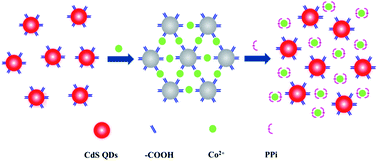Monitoring pyrophosphate anions via cobalt(ii)-modulated fluorescence of cadmium sulfide quantum dots†
Abstract
In this work, a novel and simple off–on fluorescent sensor is proposed for the selective detection of pyrophosphate (PPi) in an aqueous solution. The sensing approach is realized using fluorescent cadmium sulfide quantum dots (CdS QDs) capped with 3-mercaptopropionic acid, which displayed excellent optical properties and high photostability. The red emission of CdS QDs was significantly quenched in the presence of Co2+ (turn-off) due to the aggregation induced by the coordination between Co2+ ions and carboxyl groups on CdS QDs. However, the continuous addition of PPi can restore the fluorescence (turn-on) due to the competition between PPi and carboxyl groups to coordinate with Co2+ ions leading to the re-dispersion of CdS QDs. Thus a sensitive probing PPi method was successfully established. Under optimized conditions, the proposed fluorescent platform was used for PPi detection in the range of 0.2 to 260 μM with a detection limit of 35 nM. The fluorescence turn-off/on approach showed a highly selective response to PPi in the presence of 20 different types of species.


 Please wait while we load your content...
Please wait while we load your content...